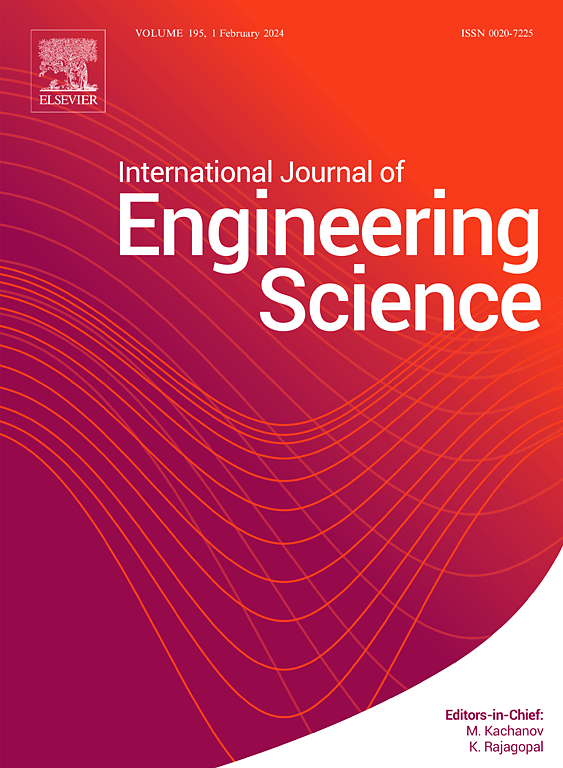电磁活性弹性体的多尺度非仿射力学:聚合物链交联、缠结和有限可扩展性的紧域可开发卷积
IF 5.7
1区 工程技术
Q1 ENGINEERING, MULTIDISCIPLINARY
International Journal of Engineering Science
Pub Date : 2025-09-16
DOI:10.1016/j.ijengsci.2025.104378
引用次数: 0
摘要
使用智能聚合物制造的驱动装置在受到外部刺激时经常表现出起皱和拉入不稳定性。这些不稳定性可能会破坏致动装置的预期功能,并阻碍其可靠性。这些不稳定性的根本原因是聚合物网络的复杂结构,导致智能弹性体膜中交联和缠结的复杂和混乱排列。当施加外力时,这种卷曲的结构显著影响聚合物的力学行为。为了更好地理解和表征这些不稳定现象,本研究开发了一个基于物理的非仿射材料模型,该模型结合了聚合物链交联、纠缠和有限可扩展性等关键因素的影响。通过考虑这些因素之间错综复杂的相互作用,该模型为智能聚合物中不稳定现象背后的机制提供了基本的见解。随后,研究了外加电磁场与紧绷畴之间的关系。研究结果表明,通过控制聚合物链交联、缠结和有限可扩展性的水平,可以有效地改变绷紧结构域的大小。我们观察到,对于给定的外加电磁场水平,增加纠缠和交联参数会导致更大的拉紧域。相反,在相同水平的电磁载荷下,聚合物链有限可扩展性的增加减少了张力域。这些认识为优化驱动装置开辟了新的途径,通过调整聚合物链的复杂特性,通过释放智能弹性体的全部多物理潜力来提高稳定性和性能。本文章由计算机程序翻译,如有差异,请以英文原文为准。
Multi-scale non-affine mechanics of electro-magneto-active elastomers: Taut domain exploitable convolution of polymer chain crosslinks, entanglements and finite extensibility
Actuation devices fabricated using smart polymers often exhibit wrinkling and pull-in instability when they are subjected to external stimulation. These instabilities can disrupt the intended functionality of the actuation devices and hinder their reliability. The underlying reason for these instabilities is the complicated architecture of the polymer network, which results in a complex and chaotic arrangement of crosslinks and entanglements in smart elastomer membranes. This convoluted structure significantly influences the mechanical behavior of the polymers when external forces are applied. To better understand and characterize these instability phenomena, the present study develops a physics-based non-affine material model incorporating the effects of critical factors like polymer chain crosslinks, entanglements, and finite extensibility. By considering the intricate interplay among these factors, the model provides fundamental insights into the mechanisms behind the instability phenomena in smart polymers. Subsequently, the study explores the relationship between the applied electromagnetic field and the taut domains. The findings reveal that the size of the taut domains can be effectively altered by manipulating the levels of polymer chain crosslinks, entanglements, and finite extensibility. It is observed that, for a given level of applied electromagnetic field, increasing the entanglement and crosslink parameter leads to a larger taut domain. Conversely, an increase in the finite extensibility of the polymer chain diminishes the taut domain under the same level of electromagnetic loading. These understandings open up new avenues for optimizing actuation devices by adjusting the intricate properties of polymer chains to enhance stability and performance by unlocking the full multi-physical potential of smart elastomers.
求助全文
通过发布文献求助,成功后即可免费获取论文全文。
去求助
来源期刊

International Journal of Engineering Science
工程技术-工程:综合
CiteScore
11.80
自引率
16.70%
发文量
86
审稿时长
45 days
期刊介绍:
The International Journal of Engineering Science is not limited to a specific aspect of science and engineering but is instead devoted to a wide range of subfields in the engineering sciences. While it encourages a broad spectrum of contribution in the engineering sciences, its core interest lies in issues concerning material modeling and response. Articles of interdisciplinary nature are particularly welcome.
The primary goal of the new editors is to maintain high quality of publications. There will be a commitment to expediting the time taken for the publication of the papers. The articles that are sent for reviews will have names of the authors deleted with a view towards enhancing the objectivity and fairness of the review process.
Articles that are devoted to the purely mathematical aspects without a discussion of the physical implications of the results or the consideration of specific examples are discouraged. Articles concerning material science should not be limited merely to a description and recording of observations but should contain theoretical or quantitative discussion of the results.
 求助内容:
求助内容: 应助结果提醒方式:
应助结果提醒方式:


